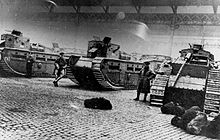Medium Mark C
| Medium Mark C (Hornet) | |
|---|---|

Main battle tank |
|
| General properties | |
| crew | 4 men |
| length | 7.86 m |
| width | 2.71 m |
| height | 2.94 m |
| Dimensions | 19.8 t |
| Armor and armament | |
| Armor | 6-14 mm |
| Main armament | 4 × 7.7 mm Hotchkiss MG |
| agility | |
| drive | RICARDO water-cooled 6-cylinder petrol engine kW (150 PS) |
| Top speed | 13 km / h |
| Power / weight | 7.5 hp / t |
| Range | 225 km |
The Medium C main battle tank was a further development of the armored vehicles already in service with the British and US Army . It was to become the main tank for the breakthrough battles planned in 1919 and, as it were, bring about the big breakthrough as cavalry , which failed in the first attempt ( Battle of Cambrai ) in 1917. Inevitably, it combined in itself the sum of the experiences that had been made in handling the Mark IV and the Mark A (Whippet) . A big step forward was the improvement of the fighting area, which now offered enough space for the entire team . In addition, the crew's seats were now connected to one another with a mouthpiece system. The engine was in a separate engine compartment and no longer in the fighting compartment, which significantly reduced the noise and smoke. Additional fans behind the tower provided better ventilation . This vehicle could also be controlled by a driver, which was completely ruled out in the previous models such as the Mark IV. Improvements to the drive were unsuccessful. The vehicle was still unsuspended, which allowed the maximum speed of 13 km / h only on the road or on flat terrain.
It was the last type of tank to be built like this.
The vehicle was a so-called “female” tank, as it only had machine guns , but not an on- board cannon . The turret was set up to accommodate five 7.7 mm Hotchkiss machine guns , but four were only assembled. The small commander's cupola on the tower had a device for an anti-aircraft gun.
The production of "male" tanks with a six-pounder cannon in a roller screen was planned, but did not get beyond a prototype.
production

After the prototype was presented in 1917 , 200 vehicles were immediately ordered, and in October 1918 another 4,000 female and 2,000 male vehicles were ordered. This order was then immediately canceled in November 1918. A total of only 36 vehicles were produced by the end of the war and then another 14, which remained in service until around 1925 and were then gradually replaced by the Vickers Medium Mark II .